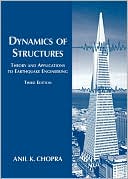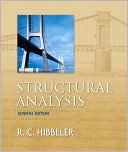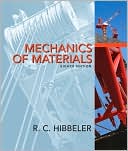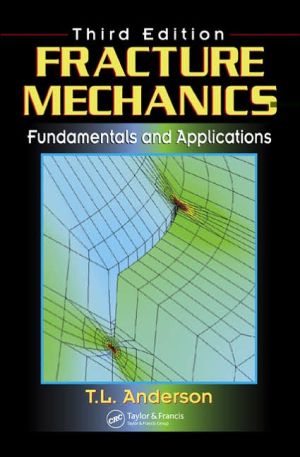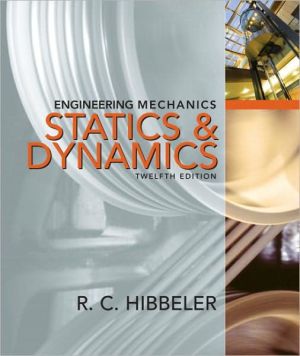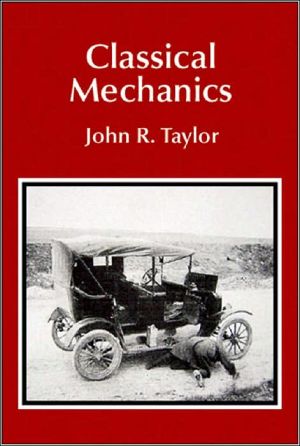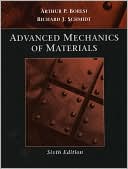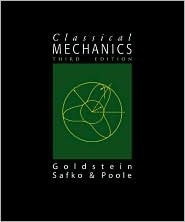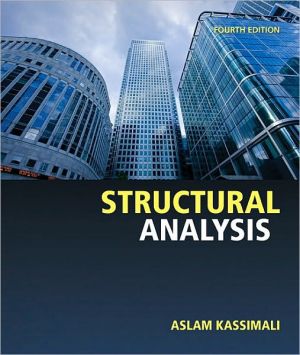Dynamics of Structures
Search in google:
Designed for senior-level and graduate courses in Dynamics of Structures and Earthquake Engineering. The text includes many topics encompassing the theory of structural dynamics and the application of this theory regarding earthquake analysis, response, and design of structures. No prior knowledge of structural dynamics is assumed and the manner of presentation is sufficiently detailed and integrated, to make the book suitable for self-study by students and professional engineers.
ContentsForeword xxiPreface xxiiiPreface to the Second Edition xxvPreface to the First Edition xxviiAcknowledgments xxxiiiPART I SINGLE-DEGREE-OF-FREEDOM SYSTEMS 1 1 Equations of Motion, Problem Statement, and Solution Methods 31.1 Simple Structures 31.2 Single-Degree-of-Freedom System 71.3 Force—Displacement Relation 81.4 Damping Force 121.5 Equation of Motion: External Force 141.6 Mass—Spring—Damper System 191.7 Equation of Motion: Earthquake Excitation 231.8 Problem Statement and Element Forces 261.9 Combining Static and Dynamic Responses 281.10 Methods of Solution of the Differential Equation 281.11 Study of SDF Systems: Organization 33Appendix 1: Stiffness Coefficients for a Flexural Element 33 2 Free Vibration 392.1 Undamped Free Vibration 392.2 Viscously Damped Free Vibration 482.3 Energy in Free Vibration 562.4 Coulomb-Damped Free Vibration 57 3 Response to Harmonic and Periodic Excitations 65Part A: Viscously Damped Systems: Basic Results 663.1 Harmonic Vibration of Undamped Systems 663.2 Harmonic Vibration with Viscous Damping 72Part B: Viscously Damped Systems: Applications 853.3 Response to Vibration Generator 853.4 Natural Frequency and Damping from Harmonic Tests 873.5 Force Transmission and Vibration Isolation 903.6 Response to Ground Motion and Vibration Isolation 913.7 Vibration-Measuring Instruments 953.8 Energy Dissipated in Viscous Damping 993.9 Equivalent Viscous Damping 103Part C: Systems with Nonviscous Damping 1053.10 Harmonic Vibration with Rate-Independent Damping 1053.11 Harmonic Vibration with Coulomb Friction 109Part D: Response to Periodic Excitation 1133.12 Fourier Series Representation 1143.13 Response to Periodic Force 114Appendix 3: Four-Way Logarithmic GraphPaper 118 4 Response to Arbitrary, Step, and Pulse Excitations 125Part A: Response to Arbitrarily Time-Varying Forces 1254.1 Response to Unit Impulse 1264.2 Response to Arbitrary Force 127Part B: Response to Step and Ramp Forces 1294.3 Step Force 1294.4 Ramp or Linearly Increasing Force 1314.5 Step Force with Finite Rise Time 132Part C: Response to Pulse Excitations 1354.6 Solution Methods 1354.7 Rectangular Pulse Force 1374.8 Half-Cycle Sine Pulse Force 1434.9 Symmetrical Triangular Pulse Force 1484.10 Effects of Pulse Shape and Approximate Analysis for Short Pulses 1514.11 Effects of Viscous Damping 1544.12 Response to Ground Motion 155 5 Numerical Evaluation of Dynamic Response 1655.1 Time-Stepping Methods 1655.2 Methods Based on Interpolation of Excitation 1675.3 Central Difference Method 1715.4 Newmark’s Method 1745.5 Stability and Computational Error 1805.6 Analysis of Nonlinear Response: Central Difference Method 1845.7 Analysis of Nonlinear Response: Newmark’s Method 184 6 Earthquake Response of Linear Systems 1976.1 Earthquake Excitation 1976.2 Equation of Motion 2036.3 Response Quantities 2046.4 Response History 2056.5 Response Spectrum Concept 2076.6 Deformation, Pseudo-velocity, and Pseudo-acceleration Response Spectra 2086.7 Peak Structural Response from the Response Spectrum 2176.8 Response Spectrum Characteristics 2226.9 Elastic Design Spectrum 2306.10 Comparison of Design and Response Spectra 2396.11 Distinction between Design and Response Spectra 2416.12 Velocity and Acceleration Response Spectra 242Appendix 6: ElCentro, 1940 Ground Motion 246 7 Earthquake Response of Inelastic Systems 2577.1 Force—Deformation Relations 2587.2 Normalized Yield Strength, Yield Strength Reduction Factor, and Ductility Factor 2647.3 Equation of Motion and Controlling Parameters 2657.4 Effects of Yielding 2667.5 Response Spectrum for Yield Deformation and Yield Strength 2737.6 Yield Strength and Deformation from the Response Spectrum 2777.7 Yield Strength—Ductility Relation 2777.8 Relative Effects of Yielding and Damping 2797.9 Dissipated Energy 2807.10 Energy Dissipation Devices 2837.11 Inelastic Design Spectrum 2887.12 Applications of the Design Spectrum 2957.13 Comparison of Design and Response Spectra 301 8 Generalized Single-Degree-of-Freedom Systems 3058.1 Generalized SDF Systems 3058.2 Rigid-Body Assemblages 3078.3 Systems with Distributed Mass and Elasticity 3098.4 Lumped-Mass System: Shear Building 3218.5 Natural Vibration Frequency by Rayleigh’s Method 3288.6 Selection of Shape Function 332Appendix 8: Inertia Forces for Rigid Bodies 336PART II MULTI-DEGREE-OF-FREEDOM SYSTEMS 343 9 Equations of Motion, Problem Statement, and SolutionMethods 3459.1 Simple System: Two-Story Shear Building 3459.2 General Approach for Linear Systems 3509.3 Static Condensation 3679.4 Planar or Symmetric-Plan Systems: Ground Motion 3709.5 Unsymmetric-Plan Buildings: Ground Motion 3759.6 Symmetric-Plan Buildings: Torsional Excitation 3839.7 Multiple Support Excitation 3849.8 Inelastic Systems 3899.9 Problem Statement 3899.10 Element Forces 3909.11 Methods for Solving the Equations of Motion: Overview 390 10 Free Vibration 401Part A: Natural Vibration Frequencies and Modes 40210.1 Systems without Damping 40210.2 Natural Vibration Frequencies and Modes 40410.3 Modal and Spectral Matrices 40610.4 Orthogonality of Modes 40710.5 Interpretation of Modal Orthogonality 40810.6 Normalization of Modes 40810.7 Modal Expansion of Displacements 418Part B: Free Vibration Response 41910.8 Solution of Free Vibration Equations: Undamped Systems 41910.9 Free Vibration of Systems with Damping 42210.10 Solution of Free Vibration Equations: Classically Damped Systems 426Part C: Computation of Vibration Properties 42810.11 Solution Methods for the Eigenvalue Problem 42810.12 Rayleigh’s Quotient 43010.13 Inverse Vector Iteration Method 43010.14 Vector Iteration with Shifts: Preferred Procedure 43510.15 Transformation of kφ = ω2mφ to the StandardForm 440 11 Damping in Structures 447Part A: Experimental Data and Recommended Modal Damping Ratios 44711.1 Vibration Properties of Millikan Library Building 44711.2 Estimating Modal Damping Ratios 452Part B: Construction of Damping Matrix 45411.3 Damping Matrix 45411.4 Classical Damping Matrix 45511.5 Nonclassical Damping Matrix 463 12 Dynamic Analysis and Response of Linear Systems 467Part A: Two-Degree-of-Freedom Systems 46712.1 Analysis of Two-DOF Systems without Damping 46712.2 Vibration Absorber or Tuned Mass Damper 470Part B: Modal Analysis 47212.3 Modal Equations for Undamped Systems 47212.4 Modal Equations for Damped Systems 47512.5 Displacement Response 47612.6 Element Forces 47712.7 Modal Analysis: Summary 477Part C: Modal Response Contributions 48212.8 Modal Expansion of Excitation Vectorp(t) = sp(t) 48212.9 Modal Analysis for p(t) = sp(t) 48612.10 Modal Contribution Factors 48712.11 Modal Responses and Required Number of Modes 489Part D: Special Analysis Procedures 49612.12 Static Correction Method 49612.13 Mode Acceleration Superposition Method 49912.14 Analysis of Nonclassically Damped Systems 500 13 Earthquake Analysis of Linear Systems 507Part A: Response History Analysis 50813.1 Modal Analysis 50813.2 Multistory Buildings with Symmetric Plan 51413.3 Multistory Buildings with Unsymmetric Plan 53313.4 Torsional Response of Symmetric-Plan Buildings 54413.5 Response Analysis for Multiple Support Excitation 54813.6 Structural Idealization and Earthquake Response 554Part B: Response Spectrum Analysis 55513.7 Peak Response from Earthquake Response Spectrum 55513.8 Multistory Buildings with Symmetric Plan 56013.9 Multistory Buildings with Unsymmetric Plan 572 14 Reduction of Degrees of Freedom 59314.1 Kinematic Constraints 59414.2 Mass Lumping in Selected DOFs 59514.3 Rayleigh—Ritz Method 59514.4 Selection of Ritz Vectors 59914.5 Dynamic Analysis Using Ritz Vectors 604 15 Numerical Evaluation of Dynamic Response 60915.1 Time-Stepping Methods 60915.2 Analysis of Linear Systems with Nonclassical Damping 61115.3 Analysis of Nonlinear Systems 618 16 Systems with Distributed Mass and Elasticity 62916.1 Equation of Undamped Motion: Applied Forces 63016.2 Equation of Undamped Motion: Support Excitation 63116.3 Natural Vibration Frequencies and Modes 63216.4 Modal Orthogonality 63916.5 Modal Analysis of Forced Dynamic Response 64116.6 Earthquake Response History Analysis 64816.7 Earthquake Response Spectrum Analysis 65316.8 Difficulty in Analyzing Practical Systems 656 17 Introduction to the Finite Element Method 661Part A: Rayleigh—Ritz Method 66117.1 Formulation Using Conservation of Energy 66117.2 Formulation Using Virtual Work 66517.3 Disadvantages of Rayleigh—Ritz Method 667Part B: Finite Element Method 66717.4 Finite Element Approximation 66717.5 Analysis Procedure 66917.6 Element Degrees of Freedom and InterpolationFunctions 67117.7 Element Stiffness Matrix 67217.8 Element Mass Matrix 67317.9 Element (Applied) Force Vector 67517.10 Comparison of Finite Element and ExactSolutions 67917.11 Dynamic Analysis of Structural Continua 680PART III EARTHQUAKE RESPONSE AND DESIGN OFMULTISTORY BUILDINGS 687 18 Earthquake Response of Linearly Elastic Buildings 68918.1 Systems Analyzed, Design Spectrum, and Response Quantities 68918.2 Influence of T1 and ¿ on Response 69418.3 Modal Contribution Factors 69518.4 Influence of T1 on Higher-Mode Response 69718.5 Influence of ¿ on Higher-Mode Response 70018.6 Heightwise Variation of Higher-Mode Response 70118.7 How Many Modes to Include 703 19 Earthquake Analysis and Response of Inelastic Buildings 707Part A: Nonlinear Response History Analysis 70819.1 Equations of Motion: Formulation and Solution 70819.2 Computing Seismic Demands: FactorsTo Be Considered 70919.3 Story Drift Demands 71319.4 Strength Demands for SDF and MDF Systems 719Part B: Approximate Analysis Procedures 72019.5 Motivation and Basic Concept 72019.6 Uncoupled Modal Response History Analysis 72219.7 Modal Pushover Analysis 72919.8 Evaluation of Modal Pushover Analysis 73419.9 Simplified Modal Pushover Analysis for Practical Application 739 20 Earthquake Dynamics of Base-Isolated Buildings 74120.1 Isolation Systems 74120.2 Base-Isolated One-Story Buildings 74420.3 Effectiveness of Base Isolation 75020.4 Base-Isolated Multistory Buildings 75420.5 Applications of Base Isolation 760 21 Structural Dynamics in Building Codes 767Part A: Building Codes and Structural Dynamics 76821.1 International Building Code (United States), 2006 76821.2 National Building Code of Canada, 2005 77121.3 Mexico Federal District Code, 2004 77321.4 Eurocode 8, 2004 77521.5 Structural Dynamics in Building Codes 778Part B: Evaluation of Building Codes 78421.6 Base Shear 78421.7 Story Shears and Equivalent Static Forces 78821.8 Overturning Moments 79021.9 Concluding Remarks 793 22 Structural Dynamics in Building Evaluation Guidelines 79522.1 Nonlinear Dynamic Procedure: Current Practice 79622.2 SDF-System Estimate of Roof Displacement 79722.3 Estimating Deformation of Inelastic SDF Systems 79922.4 Nonlinear Static Procedure 80622.5 Concluding Remarks 812A Frequency-Domain Method of Response Analysis 815B Notation 837C Answers to Selected Problems 849Index 865
